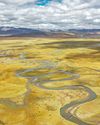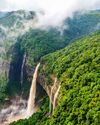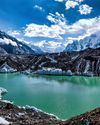
YIN-YANG REPRESENTS the changing seasons and is often recognised for its symbol, a black and white circle with two dots, denoting harmony and balance.
In ancient Chinese philosophy, the yin-yang concept teaches how opposing forces are interdependent, each giving rise to the other while complementing it.
This notion of duality highlights the balance of the world, and understanding this unique coexistence helps us break down why fluctuations in global temperatures and weather patterns can lead to the climate changes observed today.
Understanding this unique coexistence helps us break down why fluctuations in global temperatures and weather patterns can lead to the climate changes observed today
The Solar Cycle
The concept of yin-yang is illustrated by eight trigrams, commonly known as ba gua. These represent the changing seasons and were used by ancient Chinese to explain natural phenomena.
From these eight trigrams, farmers developed 24 solar terms to reflect changes in climate and natural phenomenon by mapping the sun's position. These 24 terms were listed by UNESCO in 2016 in the register of Masterpieces of the Oral and Intangible Heritage of Humanity.
Major solar terms that indicate the change of seasons are the start of spring, start of summer, start of autumn and start of winter, which are exactly three months apart. Between them, the seasons are marked by equinoxes and solstices. Consisting of 12 major and minor pairs, the solar terms are generally fixed at a 15-day interval. Eventually, after a cycle, the Earth completes a tropical year with a rotation of 360 degrees.
Yin relates to cold and wet weather, and yang, to hot and dry. With gradual changes to the composition of yin and yang as the seasons progress, changes to temperature and precipitation follow, bringing about different weather patterns.
Denne historien er fra AG 06/2021 - 151-utgaven av ASIAN Geographic.
Start din 7-dagers gratis prøveperiode på Magzter GOLD for å få tilgang til tusenvis av utvalgte premiumhistorier og 9000+ magasiner og aviser.
Allerede abonnent ? Logg på
Denne historien er fra AG 06/2021 - 151-utgaven av ASIAN Geographic.
Start din 7-dagers gratis prøveperiode på Magzter GOLD for å få tilgang til tusenvis av utvalgte premiumhistorier og 9000+ magasiner og aviser.
Allerede abonnent? Logg på

Revealed Doctor Yellow
Japan Railways' special lemony Shinkansen is a rare sight to behold

The Mighty Yellow
Over 5,000 kilometres long and flowing through nine provinces and autonomous regions, the Yellow River is China's second largest, after the Yangtze, while its basin is deemed the cradle of Chinese civilisation

Wildlife Big Yellow Beauty
The popular "amelanistic" form of the Burmese python is considered among the most beautiful snakes - if that's your sort of thing

All That Glitters Is Gold
From Turkey to China, the yellow metal plays a central role in cultural practices and is coveted as a symbol of affluence and status

Chengdu Hotel Spotlight TRIKA TSANG INTERNATIONAL HOTEL
For an authentic taste of Tibet in the heart of Chengdu, the most luxurious option is the majestic Trika Tsang International Hotel.

Conservation Yellow in Peril
While the demand for use in traditional Chinese medicine is putting seahorses under pressure, it is damaging non-selective fishing that is driving depletion

History Spiritual Rebirth
During the Spanish Golden Age, Portuguese explorer Ferdinand Magellan achieved the first European navigation to Asia via the Pacific, arriving in the Philippines in 1521 and claiming the islands for Spain. But by converting the first Filipinos to Catholicism, Magellan also instigated the Christianisation of the entire archipelago, a spiritual rebirth celebrated through the two most important festivals in the Philippines - Fiesta Señor and Sinulog.

Green Dreams
With its tea plantations and rice paddies, dense jungles and expansive forests, the region is well known as a green paradise. But many of the most impressive Asian landscapes have names you may never have heard of. Journey with us as we reveal just some of the incredible locations that make the rest of the world green with envy!

Life On The Edge
In the Chukotka Autonomous Okrug, in the remote northern Russian Far East, indigenous ethnic groups like the Chukchi and the Yupik live in the most extreme conditions, hunting seals in their traditional kayaks as they have for millennia

The Karakoram Anomaly Decoded
For decades, scientists have believed that glaciers in the Karakoram Range are defying the trend of those across the globe-resisting glacial melt due to human-induced global warming. But as we trek up the Karakoram's second-longest glacier in July, as the United Nations announces the world's hottest ever month on record, does the melting ice beneath our feet suggest the so-called Karakoram Anomaly is slowing? Or is there a ray of hope it will continue to delay the inevitable?